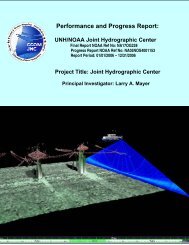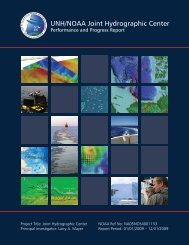Vessel Tracking Using the Automatic Identification System (AIS ...
Vessel Tracking Using the Automatic Identification System (AIS ...
Vessel Tracking Using the Automatic Identification System (AIS ...
Create successful ePaper yourself
Turn your PDF publications into a flip-book with our unique Google optimized e-Paper software.
Schwehr 2011: Presented at US Hydro, Tampa Fl 12<br />
For future responses, we can be better prepared to<br />
handle situations with a lack of infrastructure. For example,<br />
in remote islands or Alaska, <strong>the</strong>re might not be<br />
cell phone or internet coverage as <strong>the</strong>re was when near<br />
shore in <strong>the</strong> Gulf of Mexico. The concept of “response<br />
in a box” is becoming easier to build. Combining a<br />
portable GSM cellular base station (e.g. OpenBTS), a<br />
satellite link, WiFi, and an <strong>AIS</strong> ATON transceiver with<br />
a portable generator and small antenna tower would allow<br />
responders in a remote a location to be up and<br />
running with standard gear with minimal setup time.<br />
<strong>Using</strong> a satellite link, <strong>the</strong>y could be forwarding data<br />
collected via <strong>AIS</strong> and mobile phones back to normal operations<br />
facilities that require full internet connections.<br />
Additionally, now that <strong>AIS</strong> ASM messages for area<br />
notices, environmental sensor reports, and ship data reports<br />
have been approved (IMO, 2010), it is possible to<br />
send information directly to ship board electronic charts<br />
in real-time. However, <strong>the</strong>se techniques will require<br />
planning and testing to be usable under <strong>the</strong> intense<br />
pressure that occurs during incident response. <strong>AIS</strong> is<br />
a very small data link and has to be utilized carefully<br />
to not put response vessels and o<strong>the</strong>r ships in <strong>the</strong> area<br />
at increased risk. Alexander (2011) discusses some of<br />
<strong>the</strong> many issues that have to be address to make <strong>AIS</strong><br />
notices an operational success.<br />
Conclusion<br />
While it was horrible that <strong>the</strong> spill went on for so long<br />
and ended up being <strong>the</strong> worst oil spill in U.S. history,<br />
this extended time period allowed responders to iterate<br />
on techniques to improve how oil spills are managed.<br />
We owe it to future responders to work hard to capture<br />
<strong>the</strong>se experiences and lessons. This paper attempts to<br />
describe <strong>the</strong> context for how <strong>AIS</strong> was used during <strong>the</strong><br />
DWH incident. However, only limited details are available<br />
to <strong>the</strong> author. <strong>AIS</strong> as a response tool is clearly in<br />
its infancy and is not a full-proof technology. We need<br />
to continue working on creating monitoring and analysis<br />
tools that bring out <strong>the</strong> most information from <strong>AIS</strong><br />
and o<strong>the</strong>r tracking tools. It is important that in future<br />
incidents, <strong>the</strong>se tools be available during <strong>the</strong> time of<br />
response and that responders already be familiar with<br />
how to most effectively utilize <strong>the</strong>m.<br />
We now have an large database of position reports for<br />
an emergency response that occurred in an area of <strong>the</strong><br />
world with well established infrastructure. This paper<br />
only brushed <strong>the</strong> surface of <strong>the</strong> analysis that needs to be<br />
on <strong>the</strong> <strong>AIS</strong> data and <strong>the</strong> vessel traffic captured within<br />
<strong>the</strong> data stream.<br />
Disclosure<br />
During <strong>the</strong> 2004-2006 time period, I received approximately<br />
$65,000 in support from British Petroleum for<br />
my PhD research on <strong>the</strong> Santa Barbara Basin while at<br />
Scripps Institution of Oceanography. I have spent time<br />
at sea with BP staff. No funding from BP, Transocean<br />
or NOAA Office of Response and Restoration was used<br />
to support my time developing <strong>the</strong> noaadata and libais<br />
software or providing support for <strong>the</strong> oil spill response.<br />
This paper represents only <strong>the</strong> author’s opinion and<br />
does not represent NOAA, UNH, or <strong>the</strong> USCG.<br />
Acknowledgments<br />
ERMA and GeoPlatform are <strong>the</strong> work of a large<br />
number of people. The work presented here is a collaboration<br />
between NOAA ORR, UNH CRRC, UNH<br />
RCC, UNH CCOM/JHC, <strong>the</strong> USCG, NOAA nowCoast<br />
and many o<strong>the</strong>r organizations. Kurt Schwehr’s work<br />
was funded in part by NOAA grant NA05NOS4001153<br />
and money from <strong>the</strong> UNH Center for Coastal and<br />
Ocean Mapping. Collaboration with Aaron Racicot,<br />
Rob Braswell, and Michele Jacobi and <strong>the</strong> entire ERMA<br />
team were essential to <strong>the</strong> success of <strong>the</strong> <strong>AIS</strong> functionality<br />
in ERMA and GeoPlatform. NOAA ORR and<br />
<strong>the</strong> CRRC provided several of <strong>the</strong> servers used for processing<br />
and displaying <strong>AIS</strong> for ERMA. Jordan Chadwick<br />
created <strong>the</strong> Nagios tracking configuration for <strong>the</strong><br />
ERMA side of <strong>AIS</strong> processing. I would like to thank<br />
Eric S. Raymond and <strong>the</strong> members of <strong>the</strong> GPSD IRC<br />
channel for insightful discussions on many <strong>AIS</strong> issues.<br />
This paper is dedicated to <strong>the</strong> memory of Duane<br />
Robinson of <strong>the</strong> USCG Operations <strong>System</strong> Center, who<br />
supported N<strong>AIS</strong> for ERMA during 2009 and 2010.<br />
Copyright<br />
This paper is licensed under a Creative Commons<br />
Attribution-NonCommercial-NoDerivs 3.0 Unported License.<br />
Copyright 2011 Kurt Schwehr.<br />
References<br />
L. Alexander. Providing meteorological and hydrographic<br />
information via ais application specific messages:<br />
Challenges and opportunities. In Steve Barnum,<br />
editor, U.S. Hydro. CCOM/JHC, The Hydrographic<br />
Society of America, Apr 2011. hypack.com/ushydro/2011.<br />
Antelope. Environmental data collection software. Proprietary<br />
software, 2011. brtt.com.




